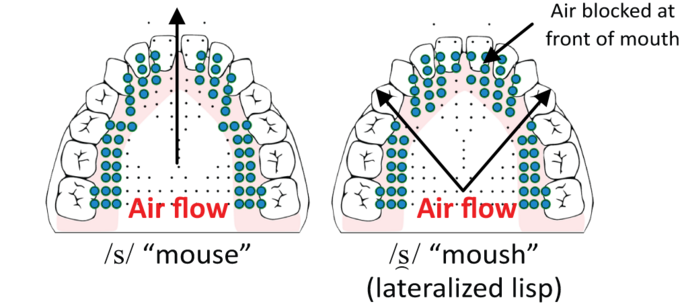
How to stop speaking with a lisp
20 January 2023

20 January 2023
One of the most common issues clients bring to me is speaking with a lisp. Here are a few suggestions on how to first identify why you lisp and then how to stop doing it.
A lisp is often caused by incorrect tongue placement. Clients with a lisp usually place their tongue behind the bottom front teeth, when it should be placed on the gum-line behind the top front teeth (the alveolar ridge).

Interestingly, the avolear ridge isn’t just used for the ‘S‘ sound, it’s also used for ‘Z’, ‘L’, ‘T’, ‘D’ & ‘N’ sounds! Therefore, if you struggle to place your tongue in the right position for an ‘S’ sound, try it on one of these sounds.
Sometimes however, a lisp may be caused by allowing the tongue to protrude past the teeth when speaking which then creates a ‘th‘ sound.
A lisp can also manifest in old age due to a fattening of the tongue thanks to a lack of communication and general muscle degradation. This is more recently becoming an issue for those isolated due to Covid-19.
Training yourself out of a lisp can be difficult, as you are constantly reinforcing yourself to place the tongue in a new position when speaking. It is normal to become frustrated when working on removing a lisp, as you’re attempting to train yourself out of a life-long habit. Thankfully, it can be done!
To alleviate a lisp, you first need to determine where you place your tongue when making an ‘S‘ sound. If your tongue is placed behind the bottom teeth, it needs to be arched upwards with the tip placed on gum-line behind the top front teeth (the alveolar ridge).
Try to avoid splaying the air out from either side of the top teeth, as this turns a crisp sound into lateralized lisp as shown below. You also want to avoid placing too much pressure on the gum line with the tip of your tongue, as that will create the same lateralized lisp. One student tried to imagine they were gently rolling an air bubble between their tongue and alveolar ridge which produced an immediate improvement.

If however your lisp is due to letting your tongue escape through the front teeth, the tongue must be pulled back into the mouth and then placed on the alveolar ridge.
One of the hardest parts to correcting a lisp is establishing new muscle memory. One simple exercise to build muscle memory is to spend a minute or two saying: ‘L, L, L,‘ by tapping the tip of your tongue on the alveolar ridge. Try not to say ‘El‘ though!
You could also try rolling the tongue in your mouth, forming different shapes and performing tongue stretches as outlined in previous posts. Thankfully, most of these exercises can be conducted in public with a closed mouth for an extended period of time! You could imagine rolling a small boiled sweet inside your mouth or attempting to tie a knot in a piece of string using your tongue. For open mouth exercises, sticking the tongue out to the far left, far right or flapping it back and forth works well, in private company!
One tool I’ve found especially useful to build muscle strength in the tongue is a Morrison Bone Prop. The shape of it also means it may help you place your tongue in the correct position, as trying to place your tongue at the incorrect position will cause the tip of your tongue to touch the device; something which you want to avoid.
If you want to try a more specialist mechanical aid, the company Speech Buddy offer a set of training devices specifically designed to help you overcome mechanical issues – advanced warning though, they are very expensive!

There are many more of these lessons, along with a comprehensive diction improvement guide available in: Speak and Be Heard – 101 Vocal Exercises for Voice Actors, Public Speakers and Professionals. Richard Di Britannia also offers private coaching on building vocal strength and confidence via his contact form.